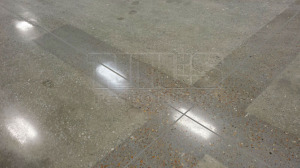
A proper concrete repair at intersecting joints that were deteriorated by heavy traffic loads.
Patching concrete floors time and time again is one way to handle repeated damage. For some properties, it’s often the only option. After all, plenty of operations simply can’t shut down for an extended period of time so that concrete can be painstakingly repaired or replaced. Other property owners believe pursuing more permanent fixes is cost-prohibitive. However, if your repeated repairs are required due to faulty joints, the problem will only continue to get worse with time.
Other problems can cause cracked concrete as well. For example, if your facility experiences heavy equipment traffic, then it’s likely that you have noticed a few cracks developing in your concrete floors. Whether your damages are due to events occurring above or below the concrete surface, there is good news. If you’re tired of continuously patching your concrete floors, there are permanent solutions available that will put an end to the constant patching.
Using the proper industrial strength materials, and applying them correctly, is important for a lasting concrete repair that can withstand heavy traffic and abuse. These repairs require a professional to correctly assess the damage and provide a tailored solution. For example, are the repairs at the expansion joints or control joints? What is the condition of the concrete beneath the surface and on the surface? And what type of traffic is the concrete exposed to? Many times it is required to remove the top damage layer completely, no more than an inch deep, prepare the concrete beneath it for a strong bond, and install a product stronger than the one previously there. Then, at the joints a proper flexible joint filler must be used to also allow concrete slabs to adjust to the temperature and humidity and move as they are intended. Addressing these areas of weakness and impact and reinforcing them, will reduce the need for constant patching and provide a lasting solution.
The best, most permanent way to avoid patching concrete floors is to have the concrete repaired professionally. High-quality compounds and joint fillers need to be applied by an expert in concrete flooring. This will result in far less surface cracks, spalls, and forklift damage caused by deteriorating joints. Filling joints is far more complicated than simply laying a bead of material along the joint line. Trusting your concrete joint filling project to an expert is the best way to ensure the very best outcomes.
In the meantime, it’s also important to use the correct materials and techniques for patching your concrete floors. Always use a high strength, high bond patching compound to fix your cracked concrete. This will guarantee that your floor is ready to handle your industrial traffic, and that it is USDA and FDA compliant if your facility is involved in food production or manufacturing. Some additional polishing can keep your patched concrete smooth, reflective, and safe for your staff to use.
Titus Restoration specializes in restoring concrete floors for clients all over the country. Titus technicians are highly trained when it comes to bringing new life to old, cracked, and worn concrete floors. Our custom high-strength patching compounds are extremely versatile and may be safely used in a wide variety of facilities.
No matter what issues you are facing with patching your concrete floors, Titus can help. Click or call us toll-free at: 888 569-3914.
